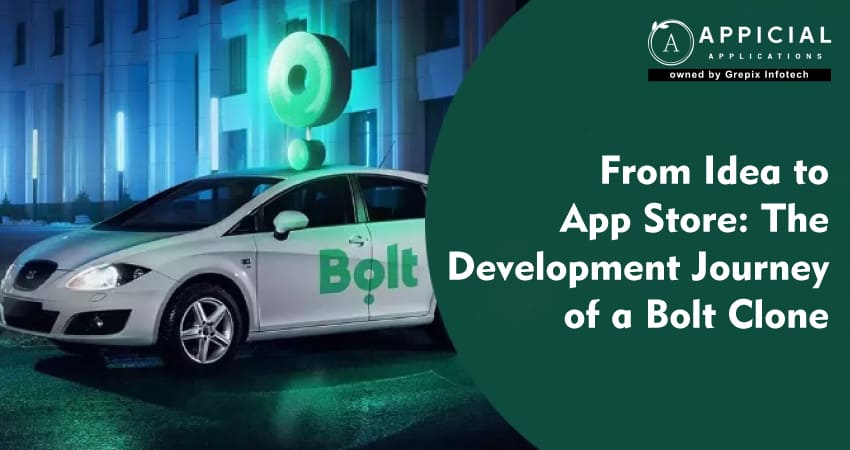
From Idea to App Store: The Development Journey of a Bolt Clone
The ride-hailing industry has revolutionized the way people commute, offering convenience, affordability, and efficiency. Companies like Bolt have set high standards in this domain, providing seamless experiences for both drivers and passengers. If you're considering developing a Bolt clone, you're aiming to enter a competitive yet rewarding market. This comprehensive guide will walk you through the development journey from conceptualization to launching your app on the App Store.
The development journey of a Bolt clone app in the ride-hailing industry encapsulates a comprehensive approach, beginning with meticulous market research and the identification of a unique selling proposition. To make the app stand out in a competitive market, it is essential to integrate both basic and advanced features, prioritize user-centered design, and choose the appropriate technology stack. The path continues through diligent phases of testing, securing compliance, deploying to app stores, and executing strategic post-launch activities. Aiming for continuous improvement and scaling into new markets, this guide details every step towards launching a successful Bolt clone app, emphasizing security, user engagement, and sustainable business practices. Engaging in such a venture offers the potential for substantial rewards in an evolving market where convenience and efficiency are paramount.
1 Conceptualization and Market Research
1.1 Understanding the Market
Before diving into development, it's crucial to understand the market landscape. Analyze the demand for ride-hailing services in your target region. Identify the existing players, their market share, and the unique value propositions they offer.
1.2 Identifying Your Unique Selling Proposition (USP)
Your app requires a unique selling proposition (USP). This could include lower prices, enhanced safety features, environmentally friendly options, or exceptional customer service. Defining your USP early on will inform your development and marketing strategies.
1.3 Feasibility Study
Conduct a feasibility study to assess the technical, economic, and legal viability of your project. This includes budgeting, resource allocation, and understanding regulatory requirements in your target regions.
2 Defining Features and Functionalities
2.1 Essential Features
- User Registration and Profiles: Simple signup processes using email, phone numbers, or social media accounts.
- Real-Time GPS Tracking: This enables users to track their rides and drivers to navigate efficiently.
- Payment Integration: Support for multiple payment options like credit/debit cards, digital wallets, and cash.
- Ride Scheduling: Option to book rides immediately or schedule for later.
- Fare Estimation: Provides users with an estimated cost before confirming the ride.
- Ratings and Reviews: Allows users and drivers to rate each other, promoting quality service.
2.2 Advanced Features
- In-App Chat and Calls: Facilitates communication between drivers and passengers without revealing personal numbers.
- Multi-Language Support: Essential for apps targeting diverse regions.
- Promotions and Discounts: Implement referral programs and promo codes to attract and retain users.
- Emergency Button: Enhances safety by allowing users to quickly contact emergency services or trusted contacts.
3 Designing the User Interface (UI) and User Experience (UX)
3.1 User-Centric Design
Focus on creating an intuitive and user-friendly interface. The design should facilitate easy navigation, quick access to features, and a seamless booking process.3.2 Wireframing and Prototyping
- Wireframing: Create basic sketches of your app's layout to plan the placement of elements.
- Prototyping: Develop interactive prototypes to test user flows and gather feedback before moving to full-scale development.
3.3 Aesthetic Elements
Choose a color scheme, typography, and design elements that resonate with your brand identity and appeal to your target audience.
4 Technical Development
4.1 Choosing the Right Technology Stack
- Frontend Development: Use frameworks like React Native or Flutter for cross-platform compatibility.
- Backend Development: Opt for robust technologies like Node.js, Python, or Java for server-side development.
- Database Management: Use scalable databases like MongoDB or PostgreSQL to handle data efficiently.
4.2 API Integration
- Maps and Navigation: Google Maps API or Mapbox for real-time navigation and route optimization.
- Payment Gateways: Stripe, PayPal, or local payment processors for secure transactions.
- SMS and Notifications: Twilio or Firebase Cloud Messaging for communication and alerts.
4.3 Development Phases
- Alpha Phase: Develop the core functionalities and test them internally.
- Beta Phase: Release to a small group of external users for broader testing and feedback.
- Release Candidate: Finalize features and fix critical bugs before the official launch.
Also Read: BlaBlaCar Clone: The Ultimate Guide to Safe Carpooling
5 Ensuring Security and Compliance
5.1Data Protection
Implement encryption protocols to protect user data during transmission and storage. Comply with data protection regulations like GDPR if operating in applicable regions.
5.2 Authentication and Authorization
Use secure authentication methods, including two-factor authentication, to prevent unauthorized access.
5.3 Regulatory Compliance
Ensure your app adheres to local transportation laws, licensing requirements, and other regulatory standards in your target markets.
6 Testing and Quality Assurance
6.1 Functional Testing
Verify that all features work as intended across different devices and operating systems.
6.2 Performance Testing
Assess the app's performance under various conditions, including load testing to see how it handles high traffic.
6.3 Security Testing
Conduct vulnerability assessments and penetration testing to identify and fix security loopholes.
6.4 Usability Testing
Gather feedback from real users to identify areas of improvement in the UI/UX.
7 Deployment to App Stores
7.1 App Store Guidelines
Familiarize yourself with the submission guidelines of the Apple App Store and Google Play Store to avoid rejections.
7.2 App Store Optimization (ASO)
Optimize your app's title, description, keywords, and screenshots to improve visibility and attract downloads.
7.3 Beta Releases
Consider releasing a beta version through platforms like TestFlight (iOS) or Google Play Console (Android) to gather initial user feedback.
7.4 Official Launch
Plan a strategic launch date, possibly accompanied by marketing campaigns to maximize impact.
8 Post-Launch Activities
8.1 Marketing and User Acquisition
Implement digital marketing strategies, including social media advertising, content marketing, and SEO to attract users.
8.2 Gathering Feedback and Iteration
Monitor user reviews and feedback to make necessary improvements and updates.
8.3 Customer Support
Establish a responsive customer support system to address user queries and issues promptly.
9 Scaling and Continuous Improvement
9.1Feature Enhancements
Regularly update your app with new features and improvements based on user needs and market trends.
9.2 Performance Monitoring
Use analytics tools to monitor app performance, user engagement, and other key metrics.
9.3 Expanding to New Markets
Once established, consider expanding your services to new regions, while keeping localization and compliance requirements in mind.
10 Monetization Strategies
10.1 Commission Model
Earn revenue by taking a commission from each ride completed through your platform.
10.2 Surge Pricing
Implement dynamic pricing during peak hours to maximize revenue.
10.3 Advertisements and Partnerships
Partner with local businesses or run in-app advertisements to generate additional income.
11 Legal and Ethical Considerations
11.1 Driver Agreements
Draft clear terms and conditions for drivers, outlining commission rates, conduct guidelines, and other essential policies.
11.2 Insurance and Liability
Ensure appropriate insurance coverage is in place to protect your company and users in case of accidents or disputes.
11.3 Ethical Practices
Promote fair treatment of drivers and users, fostering trust and credibility in your brand.
12 Building a Sustainable Business Model
12.1 Financial Planning
Maintain a robust financial plan to manage operational costs, marketing expenses, and revenue projections.
12.2 Investor Relations
If seeking funding, prepare detailed business plans and pitch decks to attract potential investors.
12.3 Corporate Social Responsibility (CSR)
Engage in CSR activities, such as eco-friendly initiatives or community support programs, to enhance your brand image.
Conclusion
Embarking on the journey to develop a Bolt clone app is an ambitious and rewarding endeavor. The ride-hailing industry continues to grow, driven by the increasing demand for convenient, affordable, and efficient transportation solutions. By thoroughly understanding the market, defining a unique selling proposition, and meticulously planning each phase from conceptualization to deployment you position your app for success in a competitive landscape.
Key steps such as integrating essential and advanced features, prioritizing user-centric design, and choosing the right technology stack lay a solid foundation for your app. Ensuring security, and compliance, and conducting rigorous testing are critical to building trust with users and providing a seamless experience. Post-launch activities like effective marketing, continuous improvement, and exploring monetization strategies further enhance your app's viability and growth potential.
Appicial Applications is a leading taxi app development company specializing in transforming innovative ideas into successful ride-hailing applications. Our expertise encompasses every aspect outlined in this blog, from market research and UI/UX design to technical development and post-launch support. We are committed to delivering solutions that are not only technologically robust but also aligned with your business goals and the evolving needs of the market.
By partnering with us, you gain access to a team dedicated to excellence and innovation. We understand the nuances of the ride-hailing industry and are equipped to navigate the challenges of developing a Bolt clone app. Let us help you turn your vision into a reality and drive your venture toward sustained success in the dynamic world of ride-sharing services.
Looking out to start your own venture like Uber? Try out our HireMe Uber Clone, the easiest way to kick-start your taxi business.




